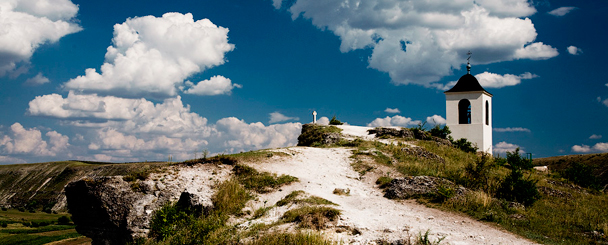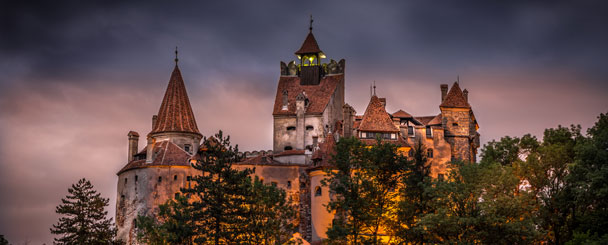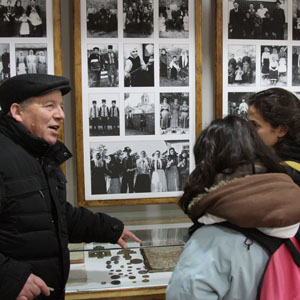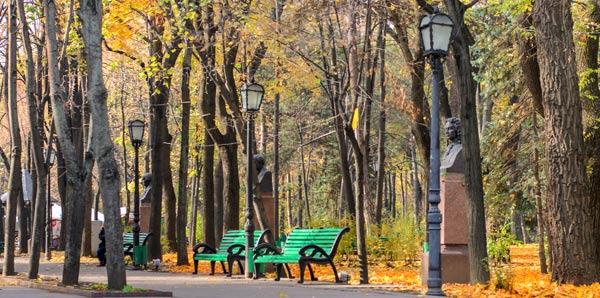Moldova, a hidden gem in Eastern Europe, is perfect for learning Romanian or Russian. Its capital, Chisinau, blends modern amenities with rich traditions, offering charming parks, lively markets, and a vibrant cultural scene. Beyond the city, explore wineries, ancient monasteries, and Moldova's unique mix of Romanian and Slavic heritage.
Old Orhei
Archeological excavations discovered here the cultural layers of different epochs such as the Paleolithic, Eneolithic, and Iron Age. Old Orhei contains traces of different civilizations, including the earthen and wooden fortresses (6th-1st centuries BC), a Golden Horde fort (14th century), a Moldavian fort (14th-16th centuries), and Orthodox monasteries (14th century).
There is a well maintained and still active Orthodox cave monastery and an archeological museum that we will visit. There is also a church built in neo-Russian style (neo-Russian style means it is somewhat old and not really Russian).
We will also visit a traditional 19th-century peasant household, where we will see traditional handicrafts and agricultural implements of that era. We will see the remains of the Tartar baths (the Tartars being the people who came from afar to kill and rob the Moldovans). Apparently, they wanted to wash off after that. And then we are ready to sample the Moldovan cheese pies.
Milestii Mici Wine Tour
Twenty kilometres from Chisinau there is a small town of Milestii Mici. But this small town is known worldwide because The State Enterprise for Quality Wines is located there. It stores, preserves and matures high-quality wines.
The enterprise runs underground cellars whose combined length is 200 kilometres. The limestone in the galleries maintains constant humidity (85–95%) and temperature (12 °C (54 °F) – 14 °C (57 °F)) throughout the year. The longer some specific red wines are stored in such ideal conditions, the more they improve. Some wines are cellared for several decades before being sold.
In August 2005, Milestii Mici was registered in the Guinness World Records as the biggest wine collection in the world. Overall, the complex holds nearly 2 million bottles. More than 70% of the stored wines are red, 20% are white and about 10% are dessert wines. The most valuable items of this collection, worth €480 a bottle, were produced in 1973–74; they are now exported only to Japan.
Cricova Wine Cellars
Half of the roadways are used for wine storage. The roads are named by the wines they store. This "wine city" has its warehouses, tasting rooms and other facilities underground. It goes down to 100 meters below ground and holds 1.25 million bottles of rare wine. The oldest wine dates back to 1902. The temperature is maintained at about 12 °C (54 °F) all year round (which is perfect for wine).
Cricova is one of the very few wineries in the world that produce sparkling wines in accordance with the classical French method, invented centuries ago by the monk Dom Perignon. Cricova makes a unique sparkling red wine, Kodrinskoie-sparkling, made from cabernet sauvignon stocks and marketed as having a 'rich velvet texture and a blackcurrant and cherry taste'.
The "Grand Cellars of Cricova" house a remarkable collection of wines – The National Oenotec. However, the pride of the Oenotec are, first of all, the wines bearing the name "Cricova", which brought the winery a collection of national and international tasting awards. As of 2008, the collection consists of over 70 silver, gold and Grand Prix awards.
Soroka Fort
Soroca fortress was built at the Nistru river crossing, on older fortifications. In 1499, on the order of Stefan cel Mare, a square wooden fortress was built, on the site of a former Genovan fortress called as Olihonia (Alciona). Between 1543–1546 the fortress was completely rebuilt in stone, and in the shape, one can see it today – a perfect circle, the diameter of which is 37,5 m and with 5 bastions situated at equal distances. Note that the walls are not built straight, but are curved to better resist the projectiles.
Soroca’s fortress is also famous for being the place where the Moldovan army, commanded by the famous statesman Dm. Cantemir, and the Russian army, led by Tsar Petr I, consolidated their forces during the Pruth campaign against the Turks in 1711. The fortress is the only medieval monument in Moldova, which has been preserved entirely as it was designed by its builders. Above the entrance gate, one can visit the small military church.
Bucharest, Romania
Bucharest, in southern Romania, is the country's capital and commercial center. Its most iconic structure is the massive, communist-era Palace of Parliament, which has 1,100 rooms and is the second largest building in the world after the Pentagon. Nearby, the historic Lipscani district is home to an energetic nightlife scene as well as tiny Eastern Orthodox Stavropoleos Church and 15th-century Curtea Veche palace, where Prince Vlad III (“The Impaler”) once ruled.
Calea Victoriei is Bucharest's oldest and arguably, most charming street. Built in 1692 to link the Old Princely Court to Mogosoaia Palace, it was initially paved with oak beams. The street became Calea Victoriei (Victory Street) in 1878, after the Romanian War of Independence victory. Between the two world wars, Calea Victoriei developed into one of the most fashionable streets in the city.
Stroll along this street from Piata Victoriei to Piata Natiunilor Unite to discover some of the most stunning buildings in the city, including the Cantacuzino Palace, the historical Revolution Square, the Military Club, and the National History Museum.
Dracula Tour in Transylvania, Romania
We offer you the opportunity to visit the places described in the well-known tale and feel as if you are travelling with Vlad Dracula himself. He is one of the best-known real figures of Romanian history, the ruler of Walachia (a historical and geographical region of Romania) at various times from 1456-1462, who practiced impaling his enemies and by that earned reputation of excessive cruel voivode.
During our trip we’ll visit 14th century town of Sighisoara where you can visit the house in which Vlad was born; Snagov Monastery, where, according to legend, Vlad’s remains were buried; Bran Castle, commonly known as “Dracula's Castle” (one of several locations linked to the Dracula legend, including Poenari Castle and Hunyad Castle), and some others.
Odessa, Ukraine
Odessa was founded at the beginning of the 18th century and used to be the fourth largest city of the Russian Empire, after Moscow, Saint Petersburg and Warsaw. Its historical architecture has a more Mediterranean style than Russia, due to heavy French and Italian influence. Some buildings are built in a mixture of different styles, including Art Nouveau, Renaissance and Classicist.
Today, these echoes of the past are everywhere. Many of them you will see during our tour. You will see the famous 142-metre-long Potemkin Staircase (192 steps) with the amazing view of Primorsky Bulvar at the top. The stairs were constructed in 1837–1841 as a formal entrance into the city from the direction of the sea, and today are one of the best-known symbols of Odessa. Another symbol of Odessa is its Opera and Ballet Theatre, which entered the list of the most interesting sights of Eastern Europe, made by Forbes magazine in 2008.
Odessa is also a popular summer vacation destination with numerous beaches on the Black Sea Coast, seaside cafes and nightclubs.





































